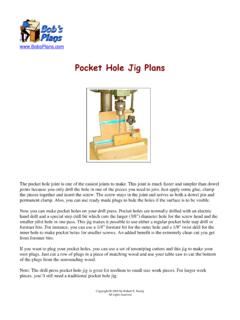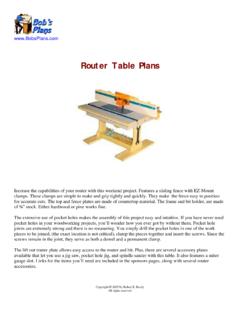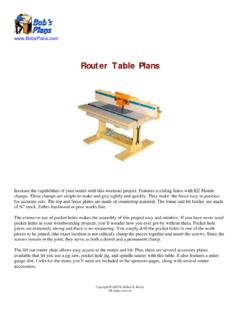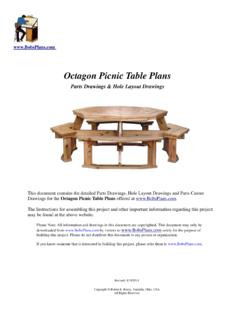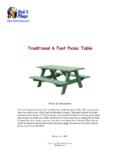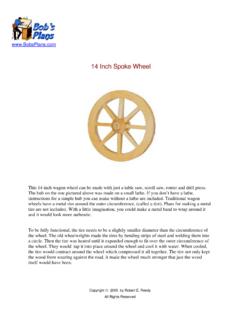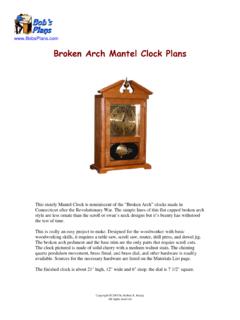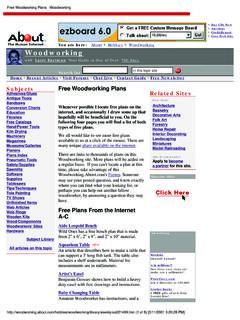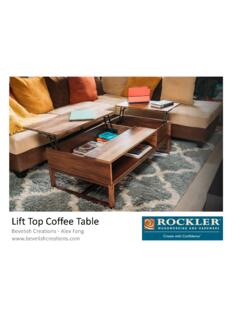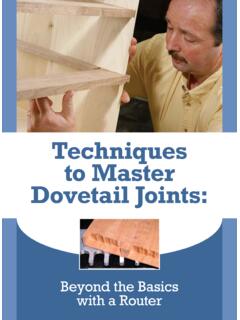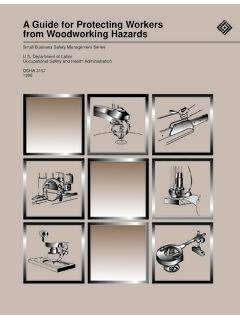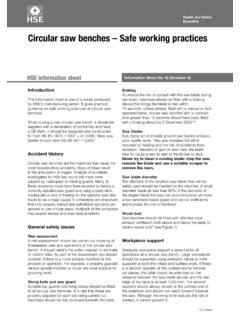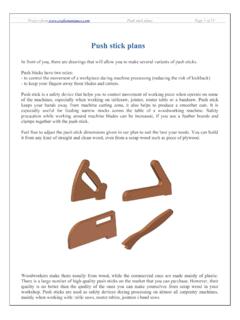Transcription of Router Table Plans - Bob's Free Woodworking Plans
1 Router Table Plans Increase the capabilities of your Router with this weekend project. Features a sliding fence with EZ-Mount clamps. These clamps are simple to make and grip tightly and quickly. They make the fence easy to position for accurate cuts. The top and fence plates are made of countertop material. The frame and bit holder, are made of stock. Either hardwood or pine works fine. The extensive use of pocket holes makes the assembly of this project easy and intuitive. If you have never used pocket holes in your Woodworking projects, you'll wonder how you ever got by without them. Pocket hole joints are extremely strong and there is no measuring. You simply drill the pocket holes in one of the work pieces to be joined, (the exact location is not critical), clamp the pieces together and insert the screws.
2 Since the screws remain in the joint, they serve as both a dowel and a permanent clamp. The lift out Router plate allows easy access to the Router and bit. Plus, there are several accessory plates available that let you use a jig saw, pocket hole jig, and spindle sander with this Table . It also features a miter gauge slot. Links for the items you'll need are included in the sponsors pages, along with several Router accessories. Copyright 2005 by Robert E. Reedy All rights reserved Table of Contents Please read and follow all tool manufacturers safety and operating instructions before operating equipment. Always wear eye and hearing protection. Materials List .. 1. Router Table Parts (A).
3 2. Router Table Parts (B) .. 3. Router Table Parts (C) .. 4. Router Table Parts (D).. 5. Assemble the Sides .. 6. Attach the Stiffeners & Legs .. 7. Attach the Feet .. 8. Bit Organizer Parts .. 9. Assembling the Bit Organizer .. 10. Fence Base Drawing (A) .. 11. Fence Drawing (B) .. 12. Stationary Faces Drawings .. 13. Support Blocks & Sliding Fence Plates .. 14. Vacuum Box and EZ-Mount Clamps .. 15. Assembling the Fence (A) .. 16. Assembling the Fence (B).. 17. Assembling the EZ-Mount Clamps .. 18. Legs Full Patterns (Top Section) .. 19. Legs Full Patterns (Bottom Section) .. 20. Introduction Thank you for purchasing our Router Table Plans . I hope you find this Router Table to be a rewarding and satisfying project.
4 For the prototype, the top and sliding sub fences were made from some old Table top material I had lying around. I chose this material because it was nice and flat and wood slides easily over it. MDF (Multi-Density Fiberboard) is an excellent choice too. Whatever material you use, make sure it is flat or you won't get accurate cuts when using it. You can make the rest of the parts from any type of wood you choose. I used popular but pine would work too. You can purchase all the parts and accessories you'll need from the companies listed on the sources page. Materials List Page 1. Router Table Materials List Qty Size Material Item Name 1 22" X 16 1" Countertop material or MDF Top 2 18" X 2 1/4" 3/4" Stock Front/Back 2 10 1/2" X 2 1/4" 3/4" Stock Ends 1 15" X 2 3/4" 3/4" Stock Front Stiffener 2 16 1/2" X 1 1/4" 3/4" Stock Rear Stiffener 2 16" X 3 1/2" 3/4" Stock Feet 2 12" X 5 1/2" 3/4" Stock Legs 1 15" X 4 1/4" 3/4" Stock Bit Organizer Top 1 15" X 2 3/4" 3/4" Stock Bit Organizer Bottom 2 15" X 1 1/4" 3/4" Stock Bit Organizer Sides 1 25" X 4" 3/4" Stock Fence Base 2 10 1/2" X 3" 3/4" Stock Stationary Fence Faces 2 12" X 4" 1" Stock Sliding Fence Plates 2 2 1/2" X 2 1/2" 1" Stock Square Fence Support Blocks 2 1 1/2" X 1 1/2" 1" Stock Beveled Fence Support
5 Blocks 1 6" X 2 1/2" 3/4" Stock Vacuum Box Rear 1 6" X 2 7/8" 3/4" Stock Vacuum Box Top 2 1 1/2" X 1" 3/4" Stock EZ-Mount Clamp Riser 2 1 1/2" X 3" 3/4" Stock EZ-Mount Clamp Block 1 8 " X 11 3/4" 1/4" Aluminum Router Plate 1 22" by 1" 1/2" Aluminum Miter Gauge Track 1 N/A Plastic Bit Safety Guard 1 48" X 3/4" 1/2" Aluminum T-Track T-Track Knobs and Bolts Copyright 2005 by Robert E Reedy, Vandalia, Ohio All Rights reserved Router Table Parts - (A). Page 2. 16". 22". p To equired). R. 1(. The top is made from 1" thick countertop material. I chose this material because I had some I. saved from an old office Table . It was nice and flat and showed no signs of warping. If you don't have access to 1" thick material, you can make do with 3/4" stock.
6 But the material must be flat. You can probably find some MDF board that is stable and flat. 2 1/4" 10 1/2". 18". 2 1/4". k ds ). ac B. nt/ uired) En uired r o F Re q eq R. 2(. 2(. The front, back, and sides are made from 3/4" Holes are 5/16" diameter, 3 1/2" from material. Drill the pockets holes as shown above. ends, 3 1/2" between centers, and 1. The exact location of the pocket holes is not 1/4" from bottom. critical. Copyright C 2005 by Robert E. Reedy, Vandalia, Ohio All Rights Reserved Router Table Parts - (B). Page 3. The stiffeners, legs, and feet are made from 3/4" stock. 1 1/4". 2 3/4". 7 1/2". 15" 16 1/2". er r en ne tiff 1" S t iffe ar S. 2" r o nt Re F. 3 1/2" Holes are 1/4" 5 1/2".
7 Diameter, 1" from ends, 3 1/2". g e between centers, ed 16" fr om and 1 1/4" from top. 1". 12". 6 1/4" Pocket Holes are 1. 1/4" from edges. Feet Legs 2 (Required) 2 (Required). Copyright C 2005 by Robert E. Reedy, Vandalia, Ohio All Rights Reserved Router Table Parts - (C). Page 4. 8 1/4". 11 3/4". 4 3/4". 5 1/8". Figure 1 Figure 2 Figure 3. To cut out the recess for the Router plate, make a frame to guide your Router as shown in Figure 1 below. You'll need a 3/4" wide straight bit for this. To determine the dimensions of the frame, make a practice cut as shown in Figure 2. Measure the distance "X" from the slot to the edge guide. The height of the frame should be 8 1/4" plus two times the distance "X" and the width of the frame should be 11 3/4" plus two times distance "X".
8 For my Router , the inside dimensions of this frame turned out to be a little more than 13" by 16". But your Router may be different so be sure to get the exact measurement and make your frame accordingly. You can assemble the frame with pocket holes as shown in Figure 1. Clamp the frame to the countertop material so the cutout will be centered side to side and the front of the cutout will be 4 3/4" from the front edge of the material. This allows room for the miter guage slot. Set the Router to cut a slot about 5/16" deep. (The Router plate is 1/4" thick but you need to have the recess a little deeper so you can set it to be flush with the Table surface. You do this by putting a flathead screw in each corner as shown in Figure 3.)
9 Then, you can adjust the screw height so the plate is flush with the top on all four corners. Be sure the frame and workpiece are securely clamped to a solid work Table or workbench and follow all safety precautions that came with your Router . Never use power tools without safety glasses and don't wear loose clothing. Your clothing can get caught up in moving parts with any type of power tool. Continued on next page. Copyright C 2005 by Robert E. Reedy, Vandalia, Ohio All Rights Reserved Router Table Parts - (D). Page 5. You can remove the center of the cutout with a jig saw. Try to leave as much material around the edge as possible. If your jig saw blade makes a 1/16" wide cut, the recess should have about an 11/16" wide edge around it.
10 Wait until the stiffeners are installed before putting the corner adjustment screws in place. 3 1/4". Cut a slot 1" wide by 1/2" deep and 3 1/4" from the front edge as shown above. Copyright C 2005 by Robert E. Reedy, Vandalia, Ohio All Rights Reserved Assemble the Sides Page 6. Assemble the four sides with a pocket hole screw in each corner as shown above. Attach the assembled sides to the underside of the top with pocket hole screws. It should be centered from front to back and side to side. Copyright C 2005 by Robert E. Reedy, Vandalia, Ohio All Rights Reserved Attach the Stiffeners & Legs to the Top Page 7. Stiffeners Attach the stiffeners to the underside of the top. Attach the legs with 1/4" by 2" carriage bolts as shown.
